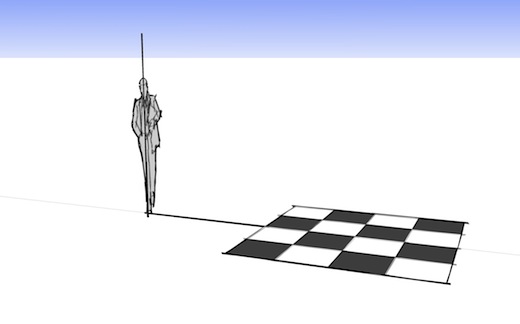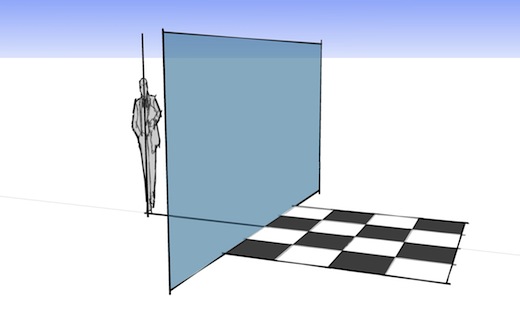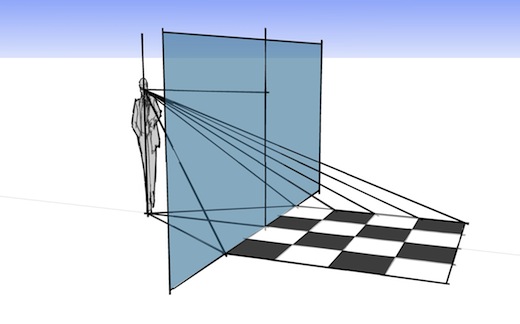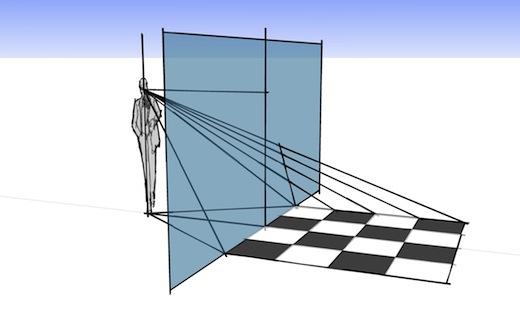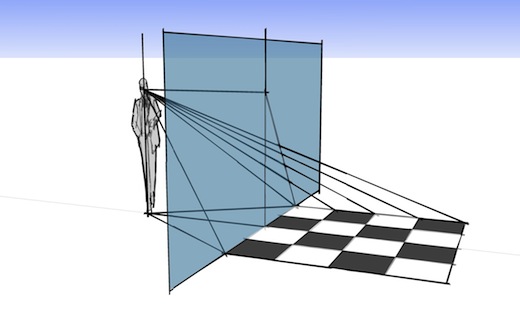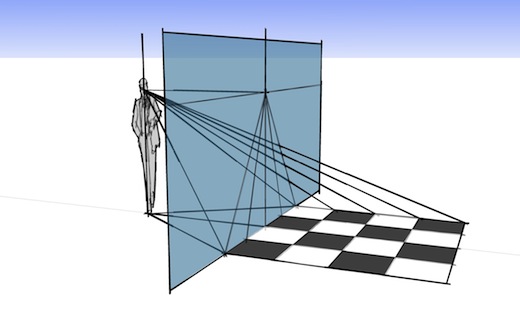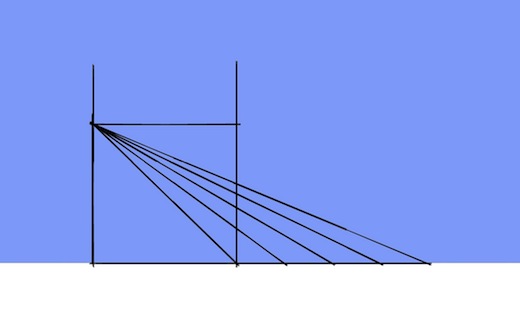"Perspective is nothing else than the seeing of an object behind a sheet of glass, smooth and quite transparent, on the surface of which all the things may be marked that are behind this glass; these things approach the point of the eye in pyramids, and these pyramids are cut by the said glass."
Leonardo Da Vinci, Notebooks, vol 2, p343 [A1v.]
A demonstration of central vanishing point perspective
(often referred to as one-point perspective)
1. Firstly, assume a gridded pavement placed on the ground plane. It is this grid that is to be drawn in perspective.
2. A person (or viewer) is placed near the grid, in line with the centre-line of the grid.
3. The 'picture plane' (shown blue) is inserted between the viewer and the grid. These are the three fundamental elements of perspective construction - the object to be drawn; the viewer; and the picture plane through which the rays of light pass.
The picture plane is at a right angle to the viewer's central line of vision. For convenience, it is aligned with the near edge of the grid.
4. A central ray or centre line is drawn from the eye to intersect the picture plane at the 'eye point'. A vertical centre line is added on the picture plane.
5. The first visual ray is drawn from a corner of the grid to the eye, intersecting the picture plane.
6. Further visual rays are drawn from other points on the grid.
7. The intersection of the a set of visual rays can then be plotted on the picture plane.
8. When this line is extended upwards, it can be seen to intersect with the eye point.
9. Other sets of points can be plotted in a similar way, to give additional lines on the picture plane, all meeting at the eye point.
10. A horizon line is added, intersecting with the eye point.
11. The intersection of the visual rays with the picture plane can also be used to give the positions the horizontal lines of the grid.
12. A plan view showing the intersection of visual rays with the picture plane.
13. A sectional view showing the height of the visual rays where they meet the picture plane.
It is no accident that Brunelleschi and Alberti who established the early principles of perspective, were architects and would have been familiar with the interrelationship between these different views of an object.
14. An elevation of the picture plane, showing the grid on the picture plane as it would appear to the viewer.
A further proof...
The above demonstration was drawn using 3D CAD software (SketchUp). We can use the software to show further proofs of perspective geometry.
If the parallel lines of the grid are extended to 'infinity', they do indeed meet at a vanishing point on the horizon, as we would expect.
Lines running perpendicularly through the grid will also meet in the vanishing point, but in this case at some distance off the page.
Diagonal lines taken through the grid squares also meet at a vanishing point on the horizon.
A demonstration of diagonal perspective
(often referred to as two-point perspective)
In this example, in the plan at the top of the drawing, the grid is placed obliquely to the viewer and picture plane.
Vanishing points are established by setting an adjustable set square parallel to one of the sets of lines in the grid. The set square is then moved in order to draw a line parallel to this through the view point (shown as one of the dashed lines). The position of the vanishing point is where this line meets the picture plane. The position of three vanishing points can be established in this way (two for the edges of the othogonal grid and one for diagonals).
A horizon line is then drawn in the space below the plan. The positions of the vanishing points can be projected down onto the horizon line.
As the near point of the grid lies on the picture plane, this point in the perspective will be at the same scale as the plan. Based on a standing figure, this would be an eye height of about 1.5 - 1.75m. The ground line is drawn at this distance below the horizon.
The near point of the grid can be projected down onto the ground line. Lines can be drawn from this to each of the three vanishing points.
In plan, visual rays can be drawn from points on the grid to the eye. The intersection of these points with the picture plane can then be projected down into the perspective drawing, establishing points for further lines that can be drawn to the appropriate vanishing points.
The diagonal vanishing point enables the process to be completely more quickly, by indicating further intersections along these lines.
This technique forms the basis for the method that is used in the 'How to...' section.
(all images copyright © Russell Light)


